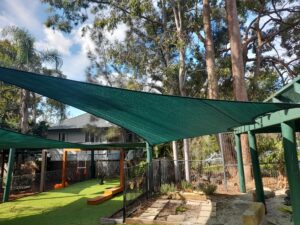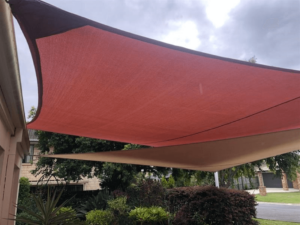We make it a point that our shade sails are able to stand the test of the elements and time. From having them made by a trusted manufacturer to installing them using best practices, nothing in the weinstallation process should be left to chance. That way, you can leave your shade sail even under bad weather without worry.
Or can you?
Unfortunately, nothing in this world made by human hands is impervious. High-quality shade sails may withstand intense UV radiation, but it doesn’t take more than the perfect storm to damage or ruin them. Neither you nor our team want to see your hard-earned investment—that could’ve lasted years—go to waste in one bad day.
Long story short, we don’t recommend leaving a shade sail up all year. You need to take it down and stow it away when the situation calls for doing so.
When To Put Away
As we’re discussing this topic, it’s the middle of cyclone season in Queensland. Everything within 50 km of the state’s long coastline will be battered by gusts of around 100 km/h. We have it relatively easy in Brisbane, as it doesn’t get as many of the severe tropical cyclones as, say, Cairns or Townsville.
While a high-quality Brisbane shade sail can be rated to resist gale-force winds (63 km/h and above), it can’t withstand them for long periods. At 90 km/h gusts, it can last for only three seconds, which—let’s face it—you’re better off taking it down. The last thing you need is strong gusts sending your custom shade sail goodness knows where.
The same applies to tornadoes. Although not as common as tropical cyclones, tornadoes form from time to time in the vast countryside. Even if the shade sail manages to weather the tornado, the debris kicked up risks tearing the fabric.
What about during a bushfire? The good news is that our high-quality shade sails have been tested and rated with a low risk of flammability and high flame resistance. For your peace of mind, the tests were performed according to the guidelines under AS 1530.
That said, “low” doesn’t mean “zero” and “high” doesn’t mean “immune.” A combination of the right conditions like an active dry spell or parched leaves can set even fire-resistant materials ablaze. Whether or not it catches fire, the heat can weaken the fabric and reduce its overall lifespan.
These scenarios suggest that taking down a shade sail is prudent during harsh weather, but it’s also a good idea when nobody will be home for a long time. No one can tell when a storm or fire will hit your neighbourhood. Consider knowing the weather conditions for the duration you or your family will be away from home.
How To Take Down
A common misconception is that shade sails are permanent structures, as not all are built that way. Some structures hold the fabric through a system of pulleys and ropes that can be loosened or secured at will. They may only look permanent because of the intricate way the ropes run through the attachment accessory.
To remove a shade sail employing a pulley system:
- Untie the rope from the cleat and let the tension loosen
- Remove each pulley mechanism from their anchor points
- Disconnect the pulley from the fabric’s attachment point
- Ensure the fabric is free of leaves and other debris
- Fold up the fabric according to its shape
- Store them in a dry place along with the pulleys and ropes
As for tools, you’ll mostly need a ladder and an adjustable wrench. Remember to exercise caution when working at heights. A fall from the top of a shade post is nothing to shrug off.
Given how large the fabric can be, it would be best to get someone to help with folding and storage. Additionally, it’s advisable to do this under light or no wind to stop the fabric from flapping and making the entire process harder than it should be.
As soon as the calamity has passed, check the forecast for the next several days or weeks to determine if it’s safe to reinstall the shade sail. If you won’t be using your outdoor space for a while, you may want to keep it in storage to extend its lifespan.
Takeaway
As much as we want high-quality shade sails to resist extreme weather elements and conditions, they need to be taken down in such situations. Keeping them away from flying debris and airborne embers preserves their integrity for a longer period. It won’t take you more than several minutes to stow your shade sail away.





